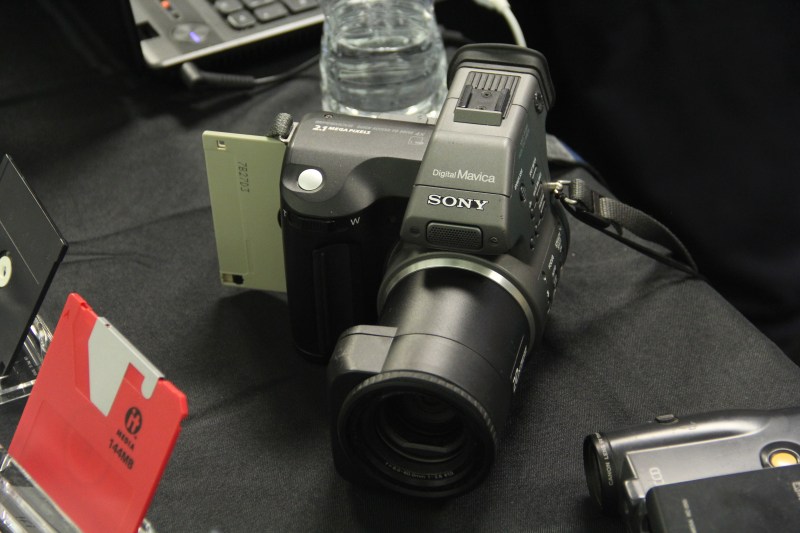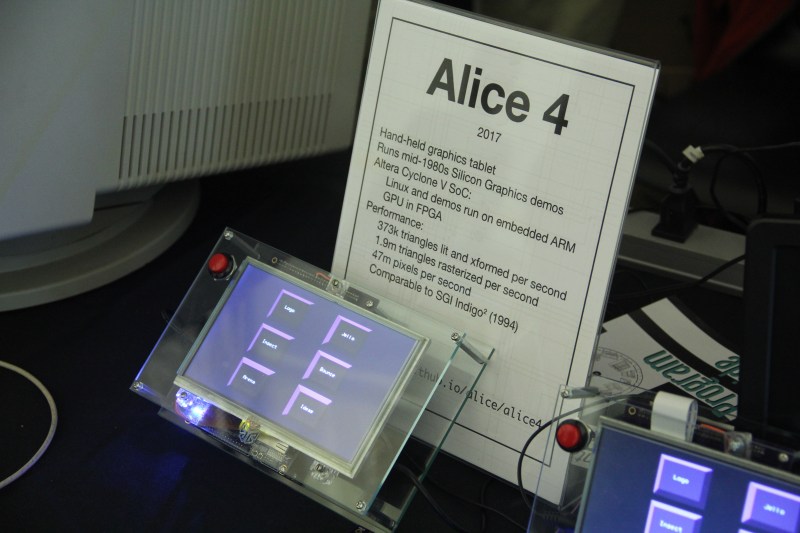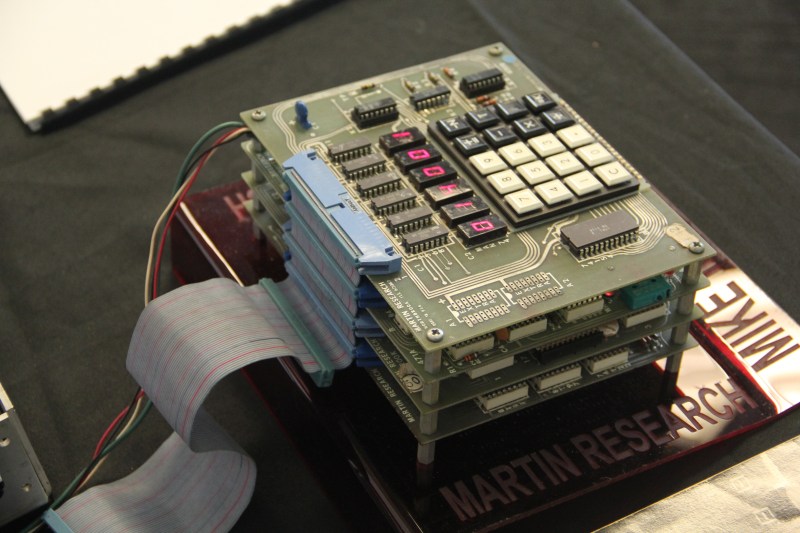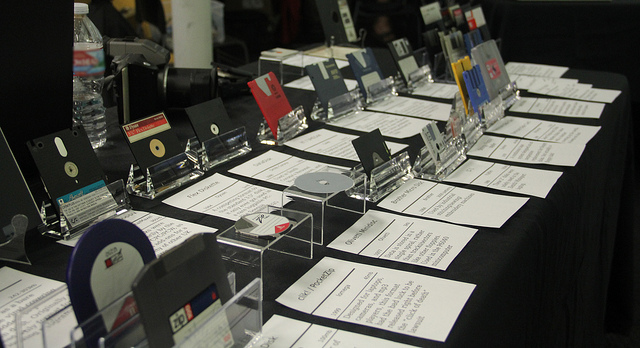This past weekend, another smashing round of the Vintage Computer Festival was held at the Computer History Museum in Mountainview. As always, VCF West gathers the sages and lords of vintage computers onto a common ground to talk old-school hardware. It also draws in a collection of unique artifacts, many of which either still work, have been brought back to life, or have otherwise been reincarnated through a modern means. [Bil Herd] and I dropped in to join the crowd, and I snagged a few pics of some new faces and pieces that have been added to the experience since last year.
[Foone’s] Digital Media Archiving
Up first on our bucket list was [Foone], a librarian of digital media archiving. Outside of VCF, he runs a digital media backup gig to help folks backup their niche, often-failing, disk formats into something more modern. His drive for doing this backup features a special “reread” capability, where the file is actually reread dozens of time to validate that the right information was pulled from it.

On-site at VCF, he brought a physical timeline of file formats from his collection onto the convention floor to give us a taste of just how far file storage has come. He also pulled a slightly more niche floppy-munching digital camera, one of the only relics of the past to store images (and video!) onto floppies. Just like shooting with a roll of film, I can imagine a pleasing aesthetic of popping floppies in-and-out to reload your camera with more shots.
Resurrecting Graphics Demos on New Hardware

[Lawrence] and company have been hard at work resurrecting old 1980’s Silicon Graphics demos on new hardware. Here, Alice 4 is the fourth iteration in a series of hardware devices to do just that. For the size and speed of the new “tablet version,” we can see just how much progress we’ve made in terms of chip speed with modern hardware. This iteration runs on a graphics pipeline synthesized on a Cyclone V (from the DEO Nano SoC kit). With some efforts, [Lawrence] and co have these demos running at a crisp 50Hz, compared to 1980s hardware rendering a new frame at about 0.5Hz.
Finally, for those eyeing the tablet case aesthetics and thinking glass, look again. The case is actually a green-edged acrylic. This material plays a nice game of tomfoolery with our expectations, and it gives the project a much fancier touch.
Past Design Principles Up-front-and-Center

VCF has no shortage of hardware. In fact, given that the unique features that yesterday’s PCs aimed to deliver is part of what makes them so vintage, the convention floor is covered in variety. From this odd conglomerate is the opportunity to pull inspiration from them. One such example is shown above. This stack of PCBs shares a common bus on the back of each board, simplifying the board-to-board wiring. What’s more, the stackable footprint and shared bus is a nifty way to join lots of boards together with a predictable form-factor. It’s so easy to overlook design patterns like these, and it’s a classy reminder that, in a world of old parts, there’s always a chance to put past ideas into something new.
The Vintage Hardware Aftermarket

Finally, no festival is complete without its bundle of at-your-own-risk vintage hardware for sale. Among the up-for-grabs components were Google servers, robot arms, and… I managed to snag a $2 copy of the PAL Device Handbook, loaded with recipes for common digital patterns like error correcting codes and state machine design and optimization for various architectures. (Of course, [Bil] already had a copy on his shelf, so I’m a bit behind in buildng my library here.) For more pics on the floor, check out the full album.
Hackaday is a proud sponsor of VCF West. You can check [Joe Kim’s] original art for the event on the attachment page.
















Can anyone provide pointers to anything that [Foone] has online regarding the work on digital media archiving? I can’t find any info on the VCF site or through Google. Surely there is a website, blog posts, or similar; I’d love to see those. TIA
Their twitter is the best place to see cool storage formats and weird devices.
https://twitter.com/foone
I don’t think there is a “special drive” so much as doing a full imaging until the checksum stabilizes. I do the same when archiving floppies – do a few images until I have consistent checksums on the resulting files. (and save all variations just in case)
Yeah, it’s not a special drive so much as a special controller. I use a Kryoflux, which is a “forensic floppy controller”.
It lets you control how many revolutions you want to sample a disk’s flux transitions over (on a regular controller, this would just be 1). So for disks which are magnetically weak, you can often recover the dying sectors by increasing your revolutions count and averaging the many runs into a single attempt at decoding a sector.
It’s similar to just running dd(/rescue) many times, but at a lower level, as you’re doing it prior to sector decoding rather than after. The problem with doing it after is that 99% of the time the sector won’t decode properly (as the CRC will be wrong) and you’ll get nothing, rather than partial data.
I don’t specifically have a page for the disk archiving. Like br3n said, I post about it on my twitter a bunch, but on-and-off as I’m working on it. I’m planning on redesigning my site soon so I’ll make sure to include a page or two about archiving of disks.
The one page I do have is a list of my collection of digital media formats: http://foone.org/w/Digital%2520Media%2520Archiving.html
“The case is actually a green-edged acrylic.”
Sort of like my CD’s with the felt tip marker to preserve audio quality!
B^)
OK, I’ll ask: where is Mountainview?
http://lmgtfy.com/?q=mountain+view%2C+ca
In Californiaunitedstates, of course!
(If you actually didn’t know and weren’t just joking about the typo, it’s in the San Francisco Bay area, northwest of San Jose)
Our Alice 4 (old SGI demos) work is documented at http://lkesteloot.github.io/alice/alice4/. Thanks for noting our project! And the acrylic is actually tinged green throughout, so the edge just shows it more.
why does that server suspiciously look like a Dell 2U server chassis that has been painted yellow?
Probably because it is. ;)
The old Google appliances were based on the 2950 series, and the last generation were based on the r710 series.
There were some oddball 1u devices based on supermicro chassis and Pentium 4’s, but they were mostly the email gateways and from what I hear didn’t have the greatest hardware reliability. (Support was top-notch though)
The 1U device you’re thinking of was probably the Google Mini. It was like the GSA but designed for smaller customers where a full blown GSA didn’t make sense. I don’t have the exact specs in front of me, but the Mini was pretty much as you describe, just a supermicro box that had the right specs for what it was doing.
Because it is. That’s a pretty standard Dell server, and the one that is the vertical one is a Gigabyte brand motherboard in a nice Google yellow case (I know this because I bought the one that’s in the picture). The horizontal one is a 2950 era machine.
Someday there will be an edit button…
Its worth mentioning that the color isn’t paint, its powder coated: https://en.wikipedia.org/wiki/Powder_coating
Very durable, but pretty much impossible to patch if you scratch it.
That stack of PCBs with the Martin Research label and the keypad, backplane, and (I assume) hex readout — I’d be interested in more information about that.
It’s a Mark III – more info here: https://plus.google.com/u/0/107049823915731374389/posts/56MvdBN2JH3
Cool stuff! I’m in the midst of building a Z80 based SBC that runs CP/M… shout-out to [256byteram] on the [dot]IO side of things for hooking me up with his kit for that… he’s real smart (and I’m somewhat impressionable) — this thing has an IDE interface in it, amongst other goodies. I might be getting spoiled here… :P
“With some efforts, [Lawrence] and co have these demos running at a crisp 50Hz, compared to 1980s hardware rendering a new frame at about 0.5Hz.”
To quote Dr. Evil, how about *no*, Scott?
Those SGI demos ran realtime on the SGI workstations of the day. That was the whole point of the damn things. They sure as hell wouldn’t be worthwhile demos if they ran at 2 seconds per frame, would they?
The demos ran at the time at various speeds on workstations of various configurations. We happened to have a Personal Iris 4D/20 at VCFWest. Other demos with less geometric complexity did run faster on that machine but Ideas in Motion ran around 1s/frame. So Joshua was just saying what he saw.
No doubt all the demos ran near 30fps or 60fps on a top-of-the-line Crimson in 1988, but even 1fps in 1988 for a 3D scene with stippled shadows and smooth shading was pretty impressive.
The Personal Iris wasn’t there as a performance comparison, though. It was meant as a nostalgic look back on the amazing SGI demos that we all loved, as a lead in to why we made our version with current technology.
Based on numbers at http://www.google.com/url?q=http%3A%2F%2Fwww.sgidepot.co.uk%2Fgfxtables.html&sa=D&sntz=1&usg=AFQjCNEqVVQ_8Zqp-2XBv17FOGMQipestw, our CPU+FPGA IrisGL partial implementation is comparable to SGI workstations around the early to mid-90’s.